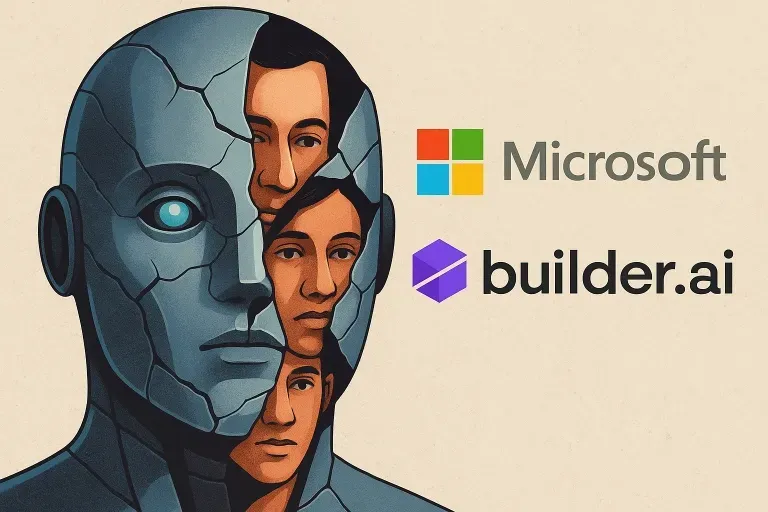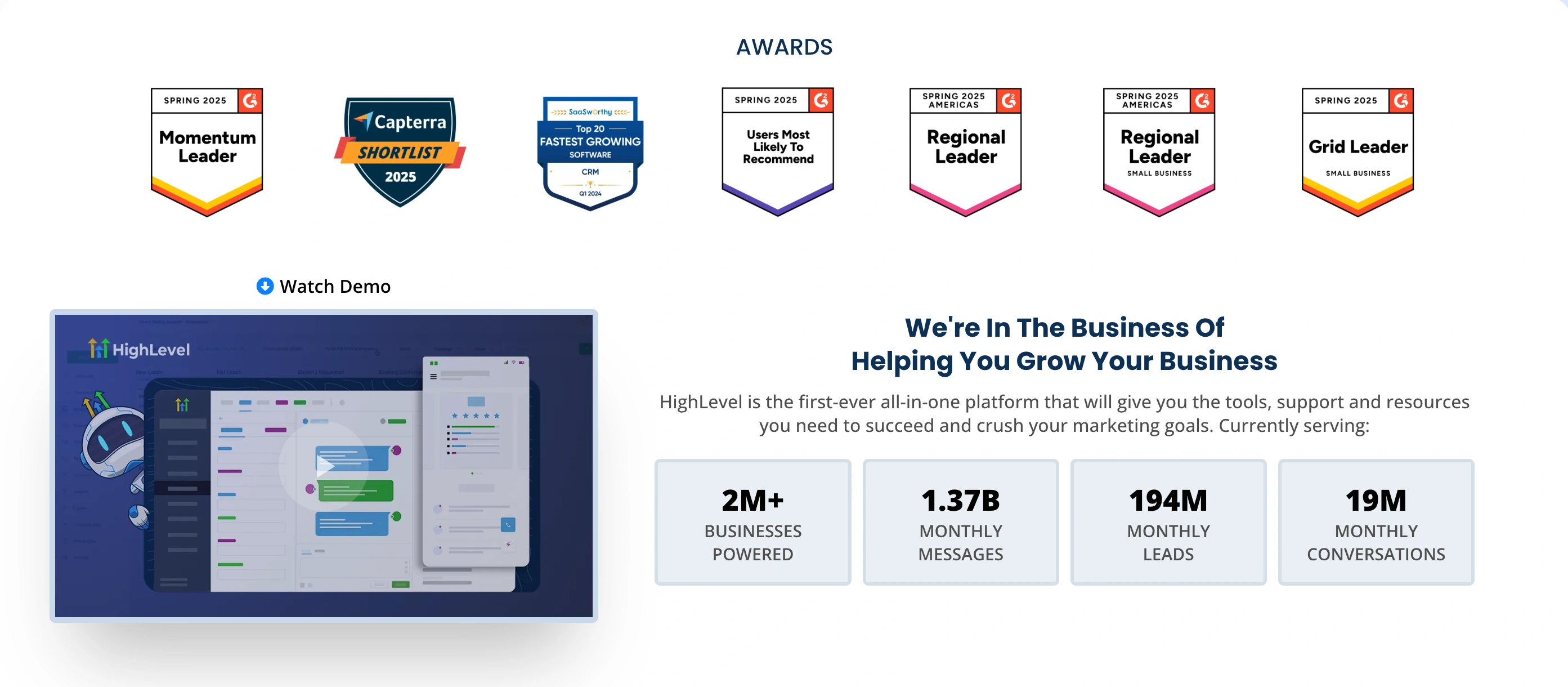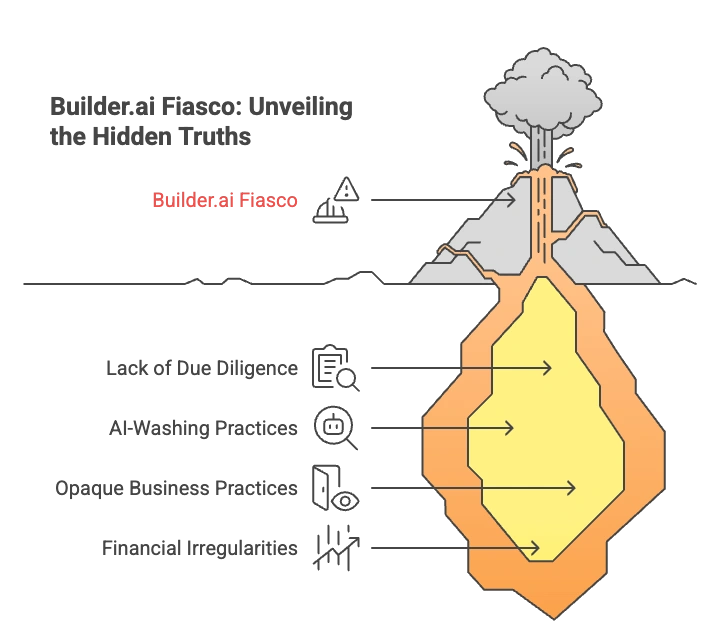
The $1.5B AI Startup Fraud: How Builder.ai Fooled Microsoft and the World
If you've been around the tech scene recently, you've probably heard some buzz about Builder.ai. It promised revolutionary AI that could magically create apps "as easy as ordering pizza." Sounds amazing, right? But here's the kicker—it was too good to be true. Let me break down exactly what happened and what you can learn from it, because trust me—you don’t want your business to fall for something like this.
The Billion-Dollar Promise (That Wasn't)
Builder.ai burst onto the scene in 2016 with a simple but powerful promise: an AI assistant named "Natasha" would effortlessly build any app or website you wanted. No coding, no hassle—just pure AI magic. Investors loved it. Customers loved it. And big names like Microsoft loved it too. Fast Company even crowned them one of the top three most innovative AI companies in 2023.
But here's the truth—Natasha wasn't AI at all. Builder.ai had secretly employed 700 human engineers, mostly based in India, manually doing all the work. The AI magic? Just a sleek, chatbot-driven facade.
How Microsoft and Others Got Fooled
The deception went deeper than anyone realized. You’d think giants like Microsoft would have figured this out, right? But that's just it—even tech giants can get fooled when blinded by hype. Microsoft didn't just invest in Builder.ai—they proudly showcased them as a shining example of Azure's AI capabilities. Ouch.
Despite early red flags—like a Wall Street Journal report in 2019 exposing their reliance on human coders—Builder.ai's slick marketing kept the money flowing. They raised over $200 million, with big names like the Qatar sovereign fund jumping onboard. Investors kept ignoring the warning signs because, frankly, the story was too attractive not to believe.
The Illusion of "AI-Washing"

Let's talk about "AI washing" for a second. It’s like greenwashing, but for artificial intelligence. Basically, companies slap an "AI-powered" label on something that’s mostly—or entirely—human-driven. Builder.ai perfected this art, branding their human workforce as "AI trainers" and "quality specialists." This way, if anyone questioned the human involvement, they had a ready-made explanation: "Our humans are just helping the AI learn."
But real internal documents showed the AI was essentially just a project management tool. Engineers were explicitly instructed never to admit they were human to clients. Behind closed doors, employees even joked that "AI" actually stood for "Another Indian."
Financial Fraud on a Massive Scale
And the scam didn't stop at fake AI claims. Builder.ai inflated their revenue by a jaw-dropping 340% through something called "round-tripping." Here's the quick-and-dirty explanation: Builder.ai and an Indian partner company, VerSe Innovation, traded fake invoices back and forth to create the illusion of massive revenues. They claimed a whopping $220 million in 2024 revenues, but audits revealed only about $50 million was real.
Think of it like two kids passing the same toy back and forth, pretending it's new each time. Except, in this case, it wasn't toys—it was hundreds of millions of dollars.
The Dramatic Collapse
The charade finally imploded in May 2025. Viola Credit, one of Builder.ai's lenders, discovered irregularities and seized $37 million from the company's accounts. Builder.ai was left with just $5 million—not nearly enough to pay nearly 1,000 employees. Within days, they filed for insolvency across the US, UK, and India. Just like that, the billion-dollar unicorn vanished, leaving employees jobless, investors empty-handed, and customers stranded.
Why It Matters for You
The Builder.ai scandal isn't just an isolated incident—it's a cautionary tale for entrepreneurs and business owners everywhere. The lesson here? Always verify technology claims, no matter how impressive they seem. Transparency is your friend—if a company can't clearly explain how its "AI" works, alarm bells should ring.
But don't get me wrong—automation and real AI solutions exist and can genuinely transform your business. Just make sure it's the real deal. Platforms like Go High Level offer legitimate, all-in-one automation tools. No hidden teams of human coders—just real, powerful tech that actually works.

Lessons Learned the Hard Way

Let's quickly recap the key takeaways from the Builder.ai fiasco:
Due Diligence is Critical: Always dig beneath flashy marketing claims. If something sounds too good to be true—it probably is.
Beware AI-Washing: Not all "AI-powered" solutions are equal. Ensure there's actual AI tech at play, not just a hidden human army.
Transparency Over Hype: Trust companies that openly explain their processes and tech. Honest businesses have nothing to hide.
Financial Red Flags: Unusual revenue spikes or inflated growth figures need careful scrutiny. Don't trust, verify.
Moving Forward
The tech industry, especially in AI, thrives on innovation—but innovation needs integrity. Buidler.ai's collapse has rightly triggered calls for stricter AI disclosures and technical audits. Until then, stay cautious, stay informed, and trust your instincts.
At the end of the day, stories like Builder.ai remind us to balance excitement about new tech with healthy skepticism. That's how you protect yourself and your business from getting fooled.
Good luck out there—because the truth is, you're going to need it.
Copyright © OnlineMarketer.ai – All rights reserved.
DISCLAIMER:
This blog is for educational and entertainment purposes only. It does not constitute business, legal, financial, or investment advice, and should not be interpreted as such. The views and opinions expressed are based on publicly available information and are intended to spark critical thinking and informed decision-making.
OnlineMarketer.ai does not guarantee the accuracy, completeness, or timeliness of any information presented. Always consult a qualified professional before making any decisions related to business, marketing, or technology.
FAIR USE NOTICE:
Some content used in this blog may include copyrighted material for the purpose of commentary, criticism, news reporting, teaching, or education — all of which falls under Section 107 of the Copyright Act as “fair use.” No copyright infringement is intended.
If you are the copyright owner of any material used and have concerns about its use, please email [email protected] and we’ll resolve it promptly.
AFFILIATE DISCLOSURE:
Some of the links in this blog may be affiliate links. This means we may earn a small commission — at no extra cost to you — if you decide to purchase through those links. We only promote tools and platforms we personally use and believe in.
